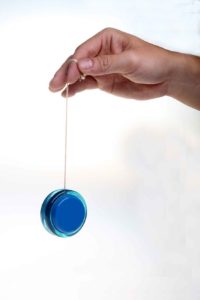5 Effective Eye Exercises to Help Improve Vision After a Concussion
Did you know a huge proportion of people who suffer a concussion experience vision problems afterwards? Even a mild brain injury can cause vision problems. This stems from disruptions in the visual brain pathways, which affect how messages transmit between the eyes and the brain.
These pathways CAN recover, though, with carefully tailored eye exercises. Also known as neuro-optometric vision rehabilitation, these simple eye exercises can go a long way in strengthening your eye muscles and helping you overcome eye problems stemming from a concussion or other traumatic brain injury (TBI).
Here are a few exercises we suggest. Keep in mind – these exercises are not meant to be a substitute for medical treatment. We are not a substitute for a neuro-optometrist. If you are experiencing vision problems, make sure you see a medical professional for a proper diagnosis. Check out NORA (The Neuro-Optometric Rehabilitation Association) for neuro-optometric rehabilitation optometrists near you.
Exercise 1: Near/Far
Sometimes after a concussion, you can find it difficult to transition your vision between objects nearby and those farther away. Near/Far exercises are designed to help you with this.
What You Need
- Two blank pieces of paper
- Tape
What You Do
- Write a letter on each of the pieces of paper
- Tape one of the papers on a far wall and stand as far away from that wall as possible
- Hold the other paper out about a foot from your face and slightly to the one side so that you can simultaneously see both the paper in your hand AND the paper on the wall
- Without moving your head, use your eyes to alternate between looking at the paper in your hand until the image is in focus, and then looking at the paper on the wall until that image is in focus
- Repeat ten times
Exercise 2: Two Thumb Exercise for Convergence Insufficiency
Convergence insufficiency happens when your eyes don’t work together as a team when you look at a nearby object. It is a common side effect after a brain injury or concussion.
What You Need
- Two thumbs
What You Do
- Hold one thumb close to your face and the other at arm’s distance from your face
- Focus your eyes on the far thumb till the fingernail looks clear
- Hold that focus for 10 seconds
- Quickly move your focus from the far thumb to the closer thumb and focus on the thumbnail of the closer thumb
- Hold that focus for 10 seconds
- Return your focus to far thumb and repeat the series 5 times, building up your tolerance to 10 times
NOTE: If you start to have increased symptoms, take a break and give your eyes time to rest.
Exercise 3: Smooth (Operator) Tracking
This exercise is geared towards improving your tracking abilities. If you find yourself struggling to use both eyes at the same time, don’t worry. You can work up to that. Start out by only using one eye at a time (you can cover the other eye or close it), and then alternate with the other eye. Eventually, you’ll be able to use both eyes at once without difficulty.
What You Need
- Something that you can swing, such as a yo-yo
What You DO
- Holding the yo-yo at eye level about an arm’s length in front of your face, swing it side to side
- Without moving your head or body, follow the yo-yo with both eyes for about a minute (or for as long as you can handle)
- Then swing the yo-yo forwards and backwards
- Every time the yo-yo approaches your face and is directly in front of you, reach out and tap it

Exercise 4: Saccades Exercises
After a concussion, your ability to move your eyes quickly may diminish, making it harder to read and focus. That’s where the saccades exercises come in handy. They were designed to improve the precision and speed of saccadic eye movements, which refer to the eye’s ability to jump quickly from one point of focus to another.
There are several types of saccadic exercises. We’re going to include horizontal and vertical. Both exercises require little more than two sticky notes and time.
Saccades Exercise- Horizontal
- Take two sticky notes and write a capital letter on each one
- Place the two sticky notes on the wall at eye level and about 12 inches apart
- Stand about 3 feet away from the wall
- Without moving your head, quickly look at the sticky note to your right
- Quickly shift your gaze to the sticky note on the left, then back to the right, then back to the left, each time allowing your eyes a few seconds to focus on the capital letter before switching sides
- Repeat these motions for about one minute, three times a day.
Saccades Exercise- Vertical
- Take two sticky notes and write a capital letter on each one
- Place the sticky notes on the wall about 12 inches apart and lined up vertically, with one about 6 inches ABOVE eye level and one about six inches BELOW eye level
- Stand about 3 feet away from the wall
- Without moving your head, look quickly at the top sticky note
- Then move your gaze to the lower sticky note, then back to the upper sticky note, and on and on, each time allowing your eyes a few seconds to focus on the capital letter before switching sticky notes
- Repeat the up-and-down eye motions for one minute, three times a day
Exercise 5: Pencil Push-Ups
These exercises target your near-sighted vision as well as your ability to focus on a moving object.
What You Need
- One pencil
What You Do
- Keeping the pencil vertical with its tip pointed up, hold the pencil out in front of you, about arm’s length away
- Focus on the tip while you slowly move the pencil away from your face
- Rinse and repeat this cycle for about ten minutes, or for however long you can handle it

NOTE: If you see two pencils instead of one as the pencil gets closer to you, you have convergence insufficiency. Stop when that occurs. Look away and give your eyes a rest for a few seconds, then look back at the pencil. If you still see double, focus on the pencil until the double vision disappears and you only see one pencil.
Ways to Get the Most Out of Your Eye Exercises
If you want to heal the eye-brain connection, you have to tap into the brain’s natural healing mechanism, which is called neuroplasticity. The best way to achieve neuroplasticity is to be consistent and disciplined, and to use massed practice.
Consistency and Discipline
Doing these exercises at the same time every day will help you stay committed to your practice, make you less likely to forget to do them, and ensure you build your eye muscles day by day.
Massed Practice Methods
This means doing several different exercises several times a day, which will help you build more neural pathways in your brain, which will then lead to improved vision.
Stick with these exercises and you WILL begin to notice an increase in your visual acuity and a decrease in your vision problems.
NOTE: Don’t feel badly if you can’t do all these exercises right away, or if you get fatigued quickly when you’re first starting out. You need to build up the muscles and the neurons again, and that takes time.
If you want to learn more about how the eye-brain partnership works, check out our article on the eye-brain connection. You can also read more about HOW a brain injury affects vision.
